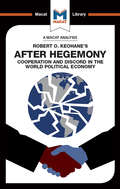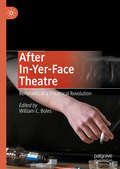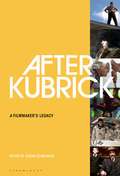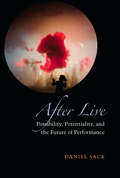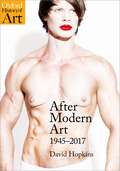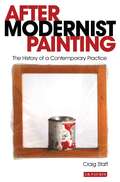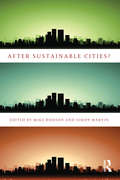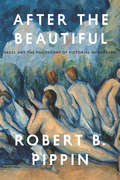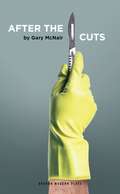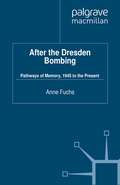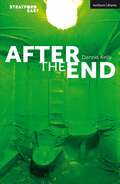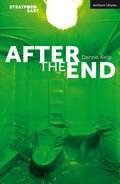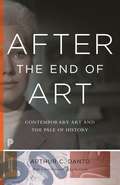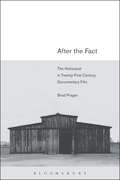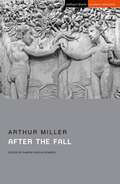- Table View
- List View
After Hegemony (The Macat Library)
by Ramon Pacheco PardoRobert O. Keohane’s After Hegemony is both a classic of international relations scholarship and an example of how creative thinking can help shed new light on the world. Since the end of World War II, the global political landscape had been dominated by two superpowers, the USA and the USSR, and the tense stand-off of the Cold War. But, as the Cold War began to thaw, it became clear that a new global model might emerge. The commonly held belief amongst those studying international relations was that it was impossible for nations to work together without the influence of a hegemon (a dominant international power) to act as both referee and ultimate decision-maker. This paradigm – neorealism – worked on the basis that every nation will do all it can to maximize its power, with such processes only checked by a balance of competing powers. Keohane, however, examined the evidence afresh and came up with novel explanations for what was likely to come next. He went outside the dominant paradigm, and argued for what came to be known as the neoliberal conception of international politics. States, Keohane said, can and will cooperate without the influence of a hegemonic power, so long as doing so brings them absolute gains in the shape of economic and cultural benefits. In Keohane’s highly-creative view, the pursuit of national self-interest leads naturally to international cooperation – and to the formation of global regimes (such as the United Nations) that can reinforce and foster it.
After Hegemony (The Macat Library)
by Ramon Pacheco PardoRobert O. Keohane’s After Hegemony is both a classic of international relations scholarship and an example of how creative thinking can help shed new light on the world. Since the end of World War II, the global political landscape had been dominated by two superpowers, the USA and the USSR, and the tense stand-off of the Cold War. But, as the Cold War began to thaw, it became clear that a new global model might emerge. The commonly held belief amongst those studying international relations was that it was impossible for nations to work together without the influence of a hegemon (a dominant international power) to act as both referee and ultimate decision-maker. This paradigm – neorealism – worked on the basis that every nation will do all it can to maximize its power, with such processes only checked by a balance of competing powers. Keohane, however, examined the evidence afresh and came up with novel explanations for what was likely to come next. He went outside the dominant paradigm, and argued for what came to be known as the neoliberal conception of international politics. States, Keohane said, can and will cooperate without the influence of a hegemonic power, so long as doing so brings them absolute gains in the shape of economic and cultural benefits. In Keohane’s highly-creative view, the pursuit of national self-interest leads naturally to international cooperation – and to the formation of global regimes (such as the United Nations) that can reinforce and foster it.
After In-Yer-Face Theatre: Remnants of a Theatrical Revolution
by William C. BolesThis book revisits In-Yer-Face theatre, an explosive, energetic theatrical movement from the 1990s that introduced the world to playwrights Sarah Kane, Martin McDonagh, Mark Ravenhill, Jez Butterworth, and many others. Split into three sections the book re-examines the era, considers the movement’s influence on international theatre, and considers its lasting effects on contemporary British theatre. The first section offers new readings on works from that time period (Antony Neilson and Mark Ravenhill) as well as challenges myths created by the Royal Court Theatre about the its involvement with In-Yer-Face theatre. The second section discusses the influence of In-Yer-Face on Portuguese, Russian and Australian theater, while the final section discusses the legacy of In-Yer-Face writers as well as their influences on more recent playwrights, including chapters on Philip Ridley, Sarah Kane, Joe Penhall, Martin Crimp, Dennis Kelly, and Verbatim Drama.
After Kubrick: A Filmmaker’s Legacy
by Jeremi SzaniawskiTaking at its starting point the idea that Kubrick's cinema has constituted an intellectual, cerebral, and philosophical maze in which many filmmakers (as well as thinkers and a substantial fringe of the general public) have gotten lost at one point or another, this collection looks at the legacy of Kubrick's films in the 21st century.The main avenues investigated are as follows: a look at Kubrick's influence on his most illustrious followers (Paul Thomas Anderson, the Coen Brothers, Christopher Nolan, Ridley Scott, and Lars von Trier, to name a few); Kubrick in critical reception; Kubrick in stylistic (camera movements, set designs, music), thematic (artificial intelligence, new frontiers- large and small), aesthetic (the question of genre, pastiche, stereoscopy) and political terms (paranoia, democracy and secret societies, conspiracy theories). The contributions coalesce around the concept of a Kubrickian substrate, rich and complex, which permeates our Western cultural landscape very much to this day, informing and sometimes announcing/reflecting it in twisted ways, 21 years after the director's death.
After Kubrick: A Filmmaker’s Legacy
Taking at its starting point the idea that Kubrick's cinema has constituted an intellectual, cerebral, and philosophical maze in which many filmmakers (as well as thinkers and a substantial fringe of the general public) have gotten lost at one point or another, this collection looks at the legacy of Kubrick's films in the 21st century.The main avenues investigated are as follows: a look at Kubrick's influence on his most illustrious followers (Paul Thomas Anderson, the Coen Brothers, Christopher Nolan, Ridley Scott, and Lars von Trier, to name a few); Kubrick in critical reception; Kubrick in stylistic (camera movements, set designs, music), thematic (artificial intelligence, new frontiers- large and small), aesthetic (the question of genre, pastiche, stereoscopy) and political terms (paranoia, democracy and secret societies, conspiracy theories). The contributions coalesce around the concept of a Kubrickian substrate, rich and complex, which permeates our Western cultural landscape very much to this day, informing and sometimes announcing/reflecting it in twisted ways, 21 years after the director's death.
After Live: Possibility, Potentiality, and the Future of Performance (Theater: Theory/Text/Performance)
by Daniel A SackIn the dark of the blackout before the curtain rises, the theater holds its many worlds suspended on the verge of appearance. How can a performance sustain this sense of potentiality that grounds all live production? Or if a stage-world does begin, what kinds of future might appear within its frame? Conceiving of the theater as a cultural institution devoted to experimenting with the future, this book begins and ends on the dramatic stage; in between it traverses literature, dance, sculpture, and performance art to explore the various futures we make in a live event. After Live conceives of traditional dramatic theater as a place for taming the future and then conceptualizes how performance beyond this paradigm might stage the unruly nature of futurity. Chapters offer insights into the plays of Beckett, Churchill, Eno, and Gombrowicz, devised theater practices, and include an extended exploration of the Italian director Romeo Castellucci. Through the lens of potentiality, other chapters present novel approaches to minimalist sculpture and dance, then reflect on how the beholder him or herself is called upon to perform when confronted by such work.
After Modern Art: 1945-2017 (Oxford History of Art)
by David HopkinsContemporary art can be baffling and beautiful, provocative and disturbing. This pioneering book presents a new look at the controversial period between 1945 and 2015, when art and its traditional forms were called into question. It focuses on the relationship between American and European art, and challenges previously held views about the origins of some of the most innovative ideas in art of this time. Major artists such as Jackson Pollock, Robert Rauschenberg, Andy Warhol, Joseph Beuys, Gerhard Richter, Louise Bourgeois, Cindy Sherman, Jeff Koons, and Shiran Neshat are all discussed, as is the art world of the last fifty years. Important trends are also covered including Abstract Expressionism, Pop Art, Minimalism, Conceptualism, Postmodernism, and Performance Art. This revised and updated second edition includes a new chapter exploring art since 2000 and how globalization has caused shifts in the art world, an updated Bibliography, and 16 new, colour illustrations.
After Modern Art: 1945-2017 (Oxford History of Art)
by David HopkinsContemporary art can be baffling and beautiful, provocative and disturbing. This pioneering book presents a new look at the controversial period between 1945 and 2015, when art and its traditional forms were called into question. It focuses on the relationship between American and European art, and challenges previously held views about the origins of some of the most innovative ideas in art of this time. Major artists such as Jackson Pollock, Robert Rauschenberg, Andy Warhol, Joseph Beuys, Gerhard Richter, Louise Bourgeois, Cindy Sherman, Jeff Koons, and Shiran Neshat are all discussed, as is the art world of the last fifty years. Important trends are also covered including Abstract Expressionism, Pop Art, Minimalism, Conceptualism, Postmodernism, and Performance Art. This revised and updated second edition includes a new chapter exploring art since 2000 and how globalization has caused shifts in the art world, an updated Bibliography, and 16 new, colour illustrations.
After Modernist Painting: The History of a Contemporary Practice (International Library of Modern and Contemporary Art)
by Craig StaffSince the publication of Clement Greenberg's 'Modernist Painting' in 1960, the status of painting and its continued legitimacy as a medium has been repeatedly placed under question. As such, painting has had to continually redefine its own parameters and re-negotiate for itself a critical position within a broader, more discursive set of discourses. Taking the American art critic's text as a point of departure, After Modernist Painting will be both a historical survey and a critical re-evaluation of the contested and contingent nature of the medium of painting over the last 50 years. Presenting the first critical account of painting, rather than art generally, this book provides a timely exploration of what has remained a persistent and protean medium. Craig Staff focuses on certain developments including the relationship of painting to Conceptual Art and Minimalism, the pronouncement of its alleged death, its response to Installation Art's foregrounding of site, how is was able to interpret ideas around appropriation, simulation and hybridity and how today it can be understood as both imaging and imagining the digital. After Modernist Painting is an invaluable resource for those seeking to understand the themes and issues that have pertained to painting within the context of postmodernism and contemporary artistic practice.
After Sustainable Cities?
by Mike Hodson Simon MarvinA sustainable city has been defined in many ways. Yet, the most common understanding is a vision of the city that is able to meet the needs of the present without compromising the ability of future generations to meet their own needs. Central to this vision are two ideas: cities should meet social needs, especially of the poor, and not exceed the ability of the global environment to meet needs.After Sustainable Cities critically reviews what has happened to these priorities and asks whether these social commitments have been abandoned in a period of austerity governance and climate change and replaced by a darker and unfair city. This book provides the first comprehensive and comparative analysis of the new eco-logics reshaping conventional sustainable cities discourse and environmental priorities of cities in both the global north and south. The dominant discourse on sustainable cities, with a commitment to intergenerational equity, social justice and global responsibility, has come under increasing pressure. Under conditions of global ecological change, international financial and economic crisis and austerity governance new eco-logics are entering the urban sustainability lexicon – climate change, green growth, smart growth, resilience and vulnerability, ecological security. This book explores how these new eco-logics reshape our understanding of equity, justice and global responsibility, and how these more technologically and economically driven themes resonate and dissonate with conventional sustainable cities discourse. This book provides a warning that a more technologically driven and narrowly constructed economic agenda is driving ecological policy and weakening previous commitment to social justice and equity. After Sustainable Cities brings together leading researchers to provide a critical examination of these new logics and identity what sort of city is now emerging, as well as consider the longer-term implication on sustainable cities research and policy.
After Sustainable Cities?
by Mike Hodson Simon MarvinA sustainable city has been defined in many ways. Yet, the most common understanding is a vision of the city that is able to meet the needs of the present without compromising the ability of future generations to meet their own needs. Central to this vision are two ideas: cities should meet social needs, especially of the poor, and not exceed the ability of the global environment to meet needs.After Sustainable Cities critically reviews what has happened to these priorities and asks whether these social commitments have been abandoned in a period of austerity governance and climate change and replaced by a darker and unfair city. This book provides the first comprehensive and comparative analysis of the new eco-logics reshaping conventional sustainable cities discourse and environmental priorities of cities in both the global north and south. The dominant discourse on sustainable cities, with a commitment to intergenerational equity, social justice and global responsibility, has come under increasing pressure. Under conditions of global ecological change, international financial and economic crisis and austerity governance new eco-logics are entering the urban sustainability lexicon – climate change, green growth, smart growth, resilience and vulnerability, ecological security. This book explores how these new eco-logics reshape our understanding of equity, justice and global responsibility, and how these more technologically and economically driven themes resonate and dissonate with conventional sustainable cities discourse. This book provides a warning that a more technologically driven and narrowly constructed economic agenda is driving ecological policy and weakening previous commitment to social justice and equity. After Sustainable Cities brings together leading researchers to provide a critical examination of these new logics and identity what sort of city is now emerging, as well as consider the longer-term implication on sustainable cities research and policy.
After the Beautiful: Hegel and the Philosophy of Pictorial Modernism
by Robert B. PippinIn his Berlin lectures on fine art, Hegel argued that art involves a unique form of aesthetic intelligibility—the expression of a distinct collective self-understanding that develops through historical time. Hegel’s approach to art has been influential in a number of different contexts, but in a twist of historical irony Hegel would die just before the most radical artistic revolution in history: modernism. In After the Beautiful, Robert B. Pippin, looking at modernist paintings by artists such as Édouard Manet and Paul Cézanne through Hegel’s lens, does what Hegel never had the chance to do. While Hegel could never engage modernist painting, he did have an understanding of modernity, and in it, art—he famously asserted—was “a thing of the past,” no longer an important vehicle of self-understanding and no longer an indispensable expression of human meaning. Pippin offers a sophisticated exploration of Hegel’s position and its implications. He also shows that had Hegel known how the social institutions of his day would ultimately fail to achieve his own version of genuine equality, a mutuality of recognition, he would have had to explore a different, new role for art in modernity. After laying this groundwork, Pippin goes on to illuminate the dimensions of Hegel’s aesthetic approach in the path-breaking works of Manet, the “grandfather of modernism,” drawing on art historians T. J. Clark and Michael Fried to do so. He concludes with a look at Cézanne, the “father of modernism,” this time as his works illuminate the relationship between Hegel and the philosopher who would challenge Hegel’s account of both modernity and art—Martin Heidegger. Elegantly inter-weaving philosophy and art history, After the Beautiful is a stunning reassessment of the modernist project. It gets at the core of the significance of modernism itself and what it means in general for art to have a history. Ultimately, it is a testament, via Hegel, to the distinctive philosophical achievements of modernist art in the unsettled, tumultuous era we have inherited.
After the Beautiful: Hegel and the Philosophy of Pictorial Modernism
by Robert B. PippinIn his Berlin lectures on fine art, Hegel argued that art involves a unique form of aesthetic intelligibility—the expression of a distinct collective self-understanding that develops through historical time. Hegel’s approach to art has been influential in a number of different contexts, but in a twist of historical irony Hegel would die just before the most radical artistic revolution in history: modernism. In After the Beautiful, Robert B. Pippin, looking at modernist paintings by artists such as Édouard Manet and Paul Cézanne through Hegel’s lens, does what Hegel never had the chance to do. While Hegel could never engage modernist painting, he did have an understanding of modernity, and in it, art—he famously asserted—was “a thing of the past,” no longer an important vehicle of self-understanding and no longer an indispensable expression of human meaning. Pippin offers a sophisticated exploration of Hegel’s position and its implications. He also shows that had Hegel known how the social institutions of his day would ultimately fail to achieve his own version of genuine equality, a mutuality of recognition, he would have had to explore a different, new role for art in modernity. After laying this groundwork, Pippin goes on to illuminate the dimensions of Hegel’s aesthetic approach in the path-breaking works of Manet, the “grandfather of modernism,” drawing on art historians T. J. Clark and Michael Fried to do so. He concludes with a look at Cézanne, the “father of modernism,” this time as his works illuminate the relationship between Hegel and the philosopher who would challenge Hegel’s account of both modernity and art—Martin Heidegger. Elegantly inter-weaving philosophy and art history, After the Beautiful is a stunning reassessment of the modernist project. It gets at the core of the significance of modernism itself and what it means in general for art to have a history. Ultimately, it is a testament, via Hegel, to the distinctive philosophical achievements of modernist art in the unsettled, tumultuous era we have inherited.
After the Beautiful: Hegel and the Philosophy of Pictorial Modernism
by Robert B. PippinIn his Berlin lectures on fine art, Hegel argued that art involves a unique form of aesthetic intelligibility—the expression of a distinct collective self-understanding that develops through historical time. Hegel’s approach to art has been influential in a number of different contexts, but in a twist of historical irony Hegel would die just before the most radical artistic revolution in history: modernism. In After the Beautiful, Robert B. Pippin, looking at modernist paintings by artists such as Édouard Manet and Paul Cézanne through Hegel’s lens, does what Hegel never had the chance to do. While Hegel could never engage modernist painting, he did have an understanding of modernity, and in it, art—he famously asserted—was “a thing of the past,” no longer an important vehicle of self-understanding and no longer an indispensable expression of human meaning. Pippin offers a sophisticated exploration of Hegel’s position and its implications. He also shows that had Hegel known how the social institutions of his day would ultimately fail to achieve his own version of genuine equality, a mutuality of recognition, he would have had to explore a different, new role for art in modernity. After laying this groundwork, Pippin goes on to illuminate the dimensions of Hegel’s aesthetic approach in the path-breaking works of Manet, the “grandfather of modernism,” drawing on art historians T. J. Clark and Michael Fried to do so. He concludes with a look at Cézanne, the “father of modernism,” this time as his works illuminate the relationship between Hegel and the philosopher who would challenge Hegel’s account of both modernity and art—Martin Heidegger. Elegantly inter-weaving philosophy and art history, After the Beautiful is a stunning reassessment of the modernist project. It gets at the core of the significance of modernism itself and what it means in general for art to have a history. Ultimately, it is a testament, via Hegel, to the distinctive philosophical achievements of modernist art in the unsettled, tumultuous era we have inherited.
After the Beautiful: Hegel and the Philosophy of Pictorial Modernism
by Robert B. PippinIn his Berlin lectures on fine art, Hegel argued that art involves a unique form of aesthetic intelligibility—the expression of a distinct collective self-understanding that develops through historical time. Hegel’s approach to art has been influential in a number of different contexts, but in a twist of historical irony Hegel would die just before the most radical artistic revolution in history: modernism. In After the Beautiful, Robert B. Pippin, looking at modernist paintings by artists such as Édouard Manet and Paul Cézanne through Hegel’s lens, does what Hegel never had the chance to do. While Hegel could never engage modernist painting, he did have an understanding of modernity, and in it, art—he famously asserted—was “a thing of the past,” no longer an important vehicle of self-understanding and no longer an indispensable expression of human meaning. Pippin offers a sophisticated exploration of Hegel’s position and its implications. He also shows that had Hegel known how the social institutions of his day would ultimately fail to achieve his own version of genuine equality, a mutuality of recognition, he would have had to explore a different, new role for art in modernity. After laying this groundwork, Pippin goes on to illuminate the dimensions of Hegel’s aesthetic approach in the path-breaking works of Manet, the “grandfather of modernism,” drawing on art historians T. J. Clark and Michael Fried to do so. He concludes with a look at Cézanne, the “father of modernism,” this time as his works illuminate the relationship between Hegel and the philosopher who would challenge Hegel’s account of both modernity and art—Martin Heidegger. Elegantly inter-weaving philosophy and art history, After the Beautiful is a stunning reassessment of the modernist project. It gets at the core of the significance of modernism itself and what it means in general for art to have a history. Ultimately, it is a testament, via Hegel, to the distinctive philosophical achievements of modernist art in the unsettled, tumultuous era we have inherited.
After the Beautiful: Hegel and the Philosophy of Pictorial Modernism
by Robert B. PippinIn his Berlin lectures on fine art, Hegel argued that art involves a unique form of aesthetic intelligibility—the expression of a distinct collective self-understanding that develops through historical time. Hegel’s approach to art has been influential in a number of different contexts, but in a twist of historical irony Hegel would die just before the most radical artistic revolution in history: modernism. In After the Beautiful, Robert B. Pippin, looking at modernist paintings by artists such as Édouard Manet and Paul Cézanne through Hegel’s lens, does what Hegel never had the chance to do. While Hegel could never engage modernist painting, he did have an understanding of modernity, and in it, art—he famously asserted—was “a thing of the past,” no longer an important vehicle of self-understanding and no longer an indispensable expression of human meaning. Pippin offers a sophisticated exploration of Hegel’s position and its implications. He also shows that had Hegel known how the social institutions of his day would ultimately fail to achieve his own version of genuine equality, a mutuality of recognition, he would have had to explore a different, new role for art in modernity. After laying this groundwork, Pippin goes on to illuminate the dimensions of Hegel’s aesthetic approach in the path-breaking works of Manet, the “grandfather of modernism,” drawing on art historians T. J. Clark and Michael Fried to do so. He concludes with a look at Cézanne, the “father of modernism,” this time as his works illuminate the relationship between Hegel and the philosopher who would challenge Hegel’s account of both modernity and art—Martin Heidegger. Elegantly inter-weaving philosophy and art history, After the Beautiful is a stunning reassessment of the modernist project. It gets at the core of the significance of modernism itself and what it means in general for art to have a history. Ultimately, it is a testament, via Hegel, to the distinctive philosophical achievements of modernist art in the unsettled, tumultuous era we have inherited.
After the Beautiful: Hegel and the Philosophy of Pictorial Modernism
by Robert B. PippinIn his Berlin lectures on fine art, Hegel argued that art involves a unique form of aesthetic intelligibility—the expression of a distinct collective self-understanding that develops through historical time. Hegel’s approach to art has been influential in a number of different contexts, but in a twist of historical irony Hegel would die just before the most radical artistic revolution in history: modernism. In After the Beautiful, Robert B. Pippin, looking at modernist paintings by artists such as Édouard Manet and Paul Cézanne through Hegel’s lens, does what Hegel never had the chance to do. While Hegel could never engage modernist painting, he did have an understanding of modernity, and in it, art—he famously asserted—was “a thing of the past,” no longer an important vehicle of self-understanding and no longer an indispensable expression of human meaning. Pippin offers a sophisticated exploration of Hegel’s position and its implications. He also shows that had Hegel known how the social institutions of his day would ultimately fail to achieve his own version of genuine equality, a mutuality of recognition, he would have had to explore a different, new role for art in modernity. After laying this groundwork, Pippin goes on to illuminate the dimensions of Hegel’s aesthetic approach in the path-breaking works of Manet, the “grandfather of modernism,” drawing on art historians T. J. Clark and Michael Fried to do so. He concludes with a look at Cézanne, the “father of modernism,” this time as his works illuminate the relationship between Hegel and the philosopher who would challenge Hegel’s account of both modernity and art—Martin Heidegger. Elegantly inter-weaving philosophy and art history, After the Beautiful is a stunning reassessment of the modernist project. It gets at the core of the significance of modernism itself and what it means in general for art to have a history. Ultimately, it is a testament, via Hegel, to the distinctive philosophical achievements of modernist art in the unsettled, tumultuous era we have inherited.
After the Cuts (Oberon Modern Plays)
by Gary McNairIt's the future; just like now, but a bit more... well, sh*tey. Jim and Agnes have worked hard their whole lives and now Agnes needs a life-saving operation.With the NHS as we know it a thing of the past, they must take matters into their own hands in this darkly comic tale. What lengths will people go to for life and love?
After the Dresden Bombing: Pathways of Memory, 1945 to the Present (Palgrave Macmillan Memory Studies)
by A. FuchsAnne Fuchs traces the aftermath of the Dresden bombing in the collective imagination from 1945 to today. As a case study of an event that gained local, national and global iconicity, the book investigates the role of photography, fine art, architecture, literature and film in dialogue with the changing German socio-political landscape.
After the End (Modern Plays)
by Dennis KellyA city under attack from a nuclear blast. As the dust settles, Louise wakes to find herself in a fallout shelter with Mark, the colleague who has saved her life. They have enough water and food to last two weeks. Now they just need to find a way of surviving each other. A chilling post-nuclear play that examines what it takes to endure catastrophe.After the End was originally published in 2005. This revised and updated edition was published to coincide with the London production at Theatre Royal Stratford East in February 2022.
After the End (Modern Plays)
by Dennis KellyA city under attack from a nuclear blast. As the dust settles, Louise wakes to find herself in a fallout shelter with Mark, the colleague who has saved her life. They have enough water and food to last two weeks. Now they just need to find a way of surviving each other. A chilling post-nuclear play that examines what it takes to endure catastrophe.After the End was originally published in 2005. This revised and updated edition was published to coincide with the London production at Theatre Royal Stratford East in February 2022.
After the End of Art: Contemporary Art and the Pale of History - Updated Edition (Princeton Classics #112)
by Arthur C. DantoOver a decade ago, Arthur Danto announced that art ended in the sixties. Ever since this declaration, he has been at the forefront of a radical critique of the nature of art in our time. After the End of Art presents Danto's first full-scale reformulation of his original insight, showing how, with the eclipse of abstract expressionism, art has deviated irrevocably from the narrative course that Vasari helped define for it in the Renaissance. Moreover, he leads the way to a new type of criticism that can help us understand art in a posthistorical age where, for example, an artist can produce a work in the style of Rembrandt to create a visual pun, and where traditional theories cannot explain the difference between Andy Warhol's Brillo Box and the product found in the grocery store. Here we are engaged in a series of insightful and entertaining conversations on the most relevant aesthetic and philosophical issues of art, conducted by an especially acute observer of the art scene today. Originally delivered as the prestigious Mellon Lectures on the Fine Arts, these writings cover art history, pop art, "people's art," the future role of museums, and the critical contributions of Clement Greenberg--who helped make sense of modernism for viewers over two generations ago through an aesthetics-based criticism. Tracing art history from a mimetic tradition (the idea that art was a progressively more adequate representation of reality) through the modern era of manifestos (when art was defined by the artist's philosophy), Danto shows that it wasn't until the invention of Pop art that the historical understanding of the means and ends of art was nullified. Even modernist art, which tried to break with the past by questioning the ways of producing art, hinged on a narrative. Traditional notions of aesthetics can no longer apply to contemporary art, argues Danto. Instead he focuses on a philosophy of art criticism that can deal with perhaps the most perplexing feature of contemporary art: that everything is possible.
After the Fact: The Holocaust in Twenty-First Century Documentary Film
by Brad PragerAfter the Fact studies the terrain of Holocaust documentaries subsequent to the turn of the twenty-first century. Until now most studies have centered primarily on canonical films such as Shoah and Night and Fog, but over the course of the last ten years filmmaking practices have altered dramatically. Changing techniques, diminishing communities of survivors, and the public's response to familiar, even iconic imagery, have all challenged filmmakers to radically revise and newly envision how they depict the Holocaust. Innovative styles have emerged, including groundbreaking techniques of incorporating archival footage, survivor testimony, and reenactment. Carrying wider implications for the fields of Film Studies, Jewish Studies, and Visual Studies, this book closely analyzes ten contemporary and internationally produced films, most of which have hardly been touched upon in the critical literature or elsewhere.
After the Fact: The Holocaust in Twenty-First Century Documentary Film
by Brad PragerAfter the Fact studies the terrain of Holocaust documentaries subsequent to the turn of the twenty-first century. Until now most studies have centered primarily on canonical films such as Shoah and Night and Fog, but over the course of the last ten years filmmaking practices have altered dramatically. Changing techniques, diminishing communities of survivors, and the public's response to familiar, even iconic imagery, have all challenged filmmakers to radically revise and newly envision how they depict the Holocaust. Innovative styles have emerged, including groundbreaking techniques of incorporating archival footage, survivor testimony, and reenactment. Carrying wider implications for the fields of Film Studies, Jewish Studies, and Visual Studies, this book closely analyzes ten contemporary and internationally produced films, most of which have hardly been touched upon in the critical literature or elsewhere.
After the Fall: The Misfits; After The Fall; Incident At Vichy; The Price; Creation Of The World; Playing For Time (Student Editions)
by Arthur Miller'Much like Mr. Miller, Quentin is a witness to alarming public and personal catastrophes: the stock market crash, the Holocaust, the McCarthy witchhunts and the self-destruction of a show business idol to whom he is married.' NEW YORK TIMESHaunted by past romantic failures, Quentin, a New York City Jewish intellectual, retreats into his mind as he debates marrying for a third time: as he revisits past loves and losses, his mind and memory fragments under philosophical questions; are our failures really just our own? Or is possible to hide away from the mistakes of the past?One of Miller's most personal plays, After the Fall takes place almost entirely inside the mind of the play's protagonist, who is often read as a stand-in for the playwright himself. Touching on themes of the Holocaust, McCarthyism and inherited sin, the play is one of the most discussed within Miller's canon.This Methuen Drama Student Edition is edited by Ramón Espejo-Romero, with commentary and notes that explore the play's production history (including excerpts from an interview with Michael Blakemore, former Associate Director of the Royal National Theatre,) as well as the dramatic, thematic and academic debates that surround it.
